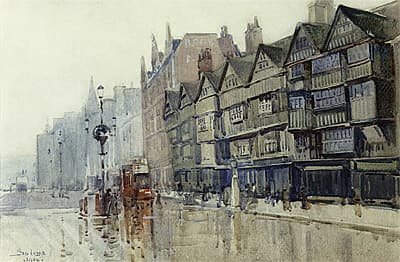Sydney
LONG
Australia
1871
–
London
1955
England, Europe 1910-21; Australia 1921- 22; England 1922-25; Australia 1925-52; England from 1952
25.0 (h) x 37.5 (w) cm
signed and dated ‘SID LONG/ 1914’ lower left Purchased 2012
As with some of his other London cityscapes, Long painted Staple Inn, Holborn in muted tones. This watercolour was probably a commission from a New Zealand doctor who, while working in one of the London hospitals during the First World War, ‘wanted a couple of London street scenes’. Long painted three.
But he did more than depict a view of a London street, he showed the scene on a wet day and, in doing so, created a slight blurring of the buildings and evocative reflections on the surface of the street. He gave the scene a double ‘ghostly’ presence in addition to its substantial one.
When he arrived in London in October 1910, Long was excited by the city, observing that ‘the old buildings are wonderful and there is such a delightful jumble of old and new mixed up’ (Long, 26 October 1910). During the war, however, he gained another view of London, reporting that ‘we had a fearful air raid yesterday morning of aeroplanes this time. They passed over within a mile of my place so I saw the whole business as far as my district was concerned’ (Long, 14 June 1917).
Staple Inn is a building on the south side of High Holborn in London, with a distinctive timber-framed facade, and an internal courtyard. Built in 1585, it was once the wool staple, where wool was weighed and taxed. It survived the Great Fire of London, but was extensively damaged by German bombers, during the Second World War, and then subsequently restored. The English author
Dr Johnson is said to have lived there between 1759 and 1760 and one of Charles Dickens’s characters, Mr Grewgious in The mystery of Edwin Drood (1870), had lodgings in the second court.
Long also made an etching of this subject in which he translated the buildings into shadowy and semi-abstract forms.
As with some of his other London cityscapes, Long painted Staple Inn, Holborn in muted tones. This watercolour was probably a commission from a New Zealand doctor who, while working in one of the London hospitals during the First World War, ‘wanted a couple of London street scenes’. Long painted three.
But he did more than depict a view of a London street, he showed the scene on a wet day and, in doing so, created a slight blurring of the buildings and evocative reflections on the surface of the street. He gave the scene a double ‘ghostly’ presence in addition to its substantial one.
When he arrived in London in October 1910, Long was excited by the city, observing that ‘the old buildings are wonderful and there is such a delightful jumble of old and new mixed up’ (Long, 26 October 1910). During the war, however, he gained another view of London, reporting that ‘we had a fearful air raid yesterday morning of aeroplanes this time. They passed over within a mile of my place so I saw the whole business as far as my district was concerned’ (Long, 14 June 1917).
Staple Inn is a building on the south side of High Holborn in London, with a distinctive timber-framed facade, and an internal courtyard. Built in 1585, it was once the wool staple, where wool was weighed and taxed. It survived the Great Fire of London, but was extensively damaged by German bombers, during the Second World War, and then subsequently restored. The English author
Dr Johnson is said to have lived there between 1759 and 1760 and one of Charles Dickens’s characters, Mr Grewgious in The mystery of Edwin Drood (1870), had lodgings in the second court.
Long also made an etching of this subject in which he translated the buildings into shadowy and semi-abstract forms.
As with some of his other London cityscapes, Long painted Staple Inn, Holborn in muted tones. This watercolour was probably a commission from a New Zealand doctor who, while working in one of the London hospitals during the First World War, ‘wanted a couple of London street scenes’. Long painted three.
But he did more than depict a view of a London street, he showed the scene on a wet day and, in doing so, created a slight blurring of the buildings and evocative reflections on the surface of the street. He gave the scene a double ‘ghostly’ presence in addition to its substantial one.
When he arrived in London in October 1910, Long was excited by the city, observing that ‘the old buildings are wonderful and there is such a delightful jumble of old and new mixed up’ (Long, 26 October 1910). During the war, however, he gained another view of London, reporting that ‘we had a fearful air raid yesterday morning of aeroplanes this time. They passed over within a mile of my place so I saw the whole business as far as my district was concerned’ (Long, 14 June 1917).
Staple Inn is a building on the south side of High Holborn in London, with a distinctive timber-framed facade, and an internal courtyard. Built in 1585, it was once the wool staple, where wool was weighed and taxed. It survived the Great Fire of London, but was extensively damaged by German bombers, during the Second World War, and then subsequently restored. The English author
Dr Johnson is said to have lived there between 1759 and 1760 and one of Charles Dickens’s characters, Mr Grewgious in The mystery of Edwin Drood (1870), had lodgings in the second court.
Long also made an etching of this subject in which he translated the buildings into shadowy and semi-abstract forms.

